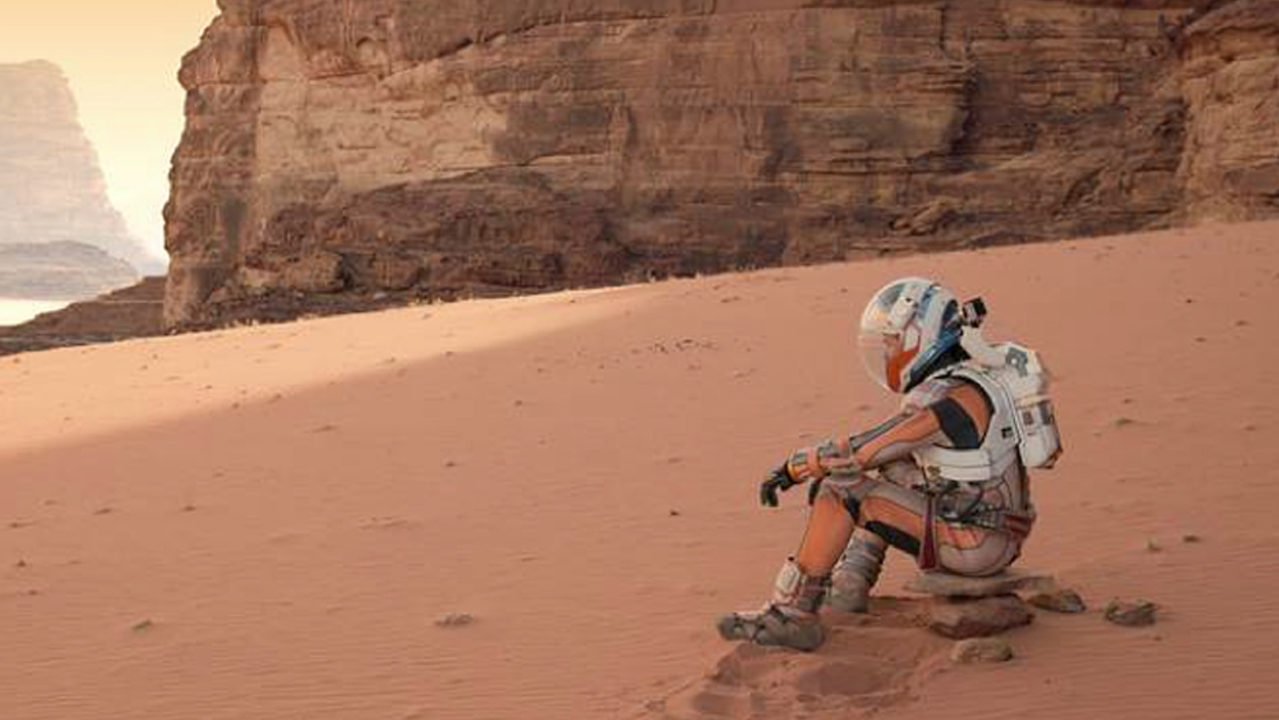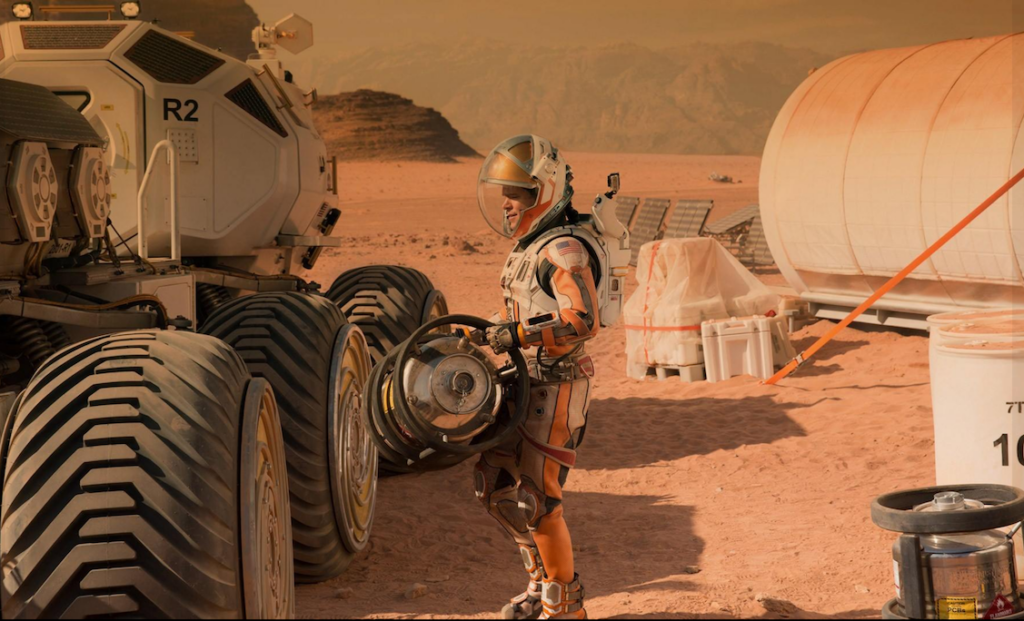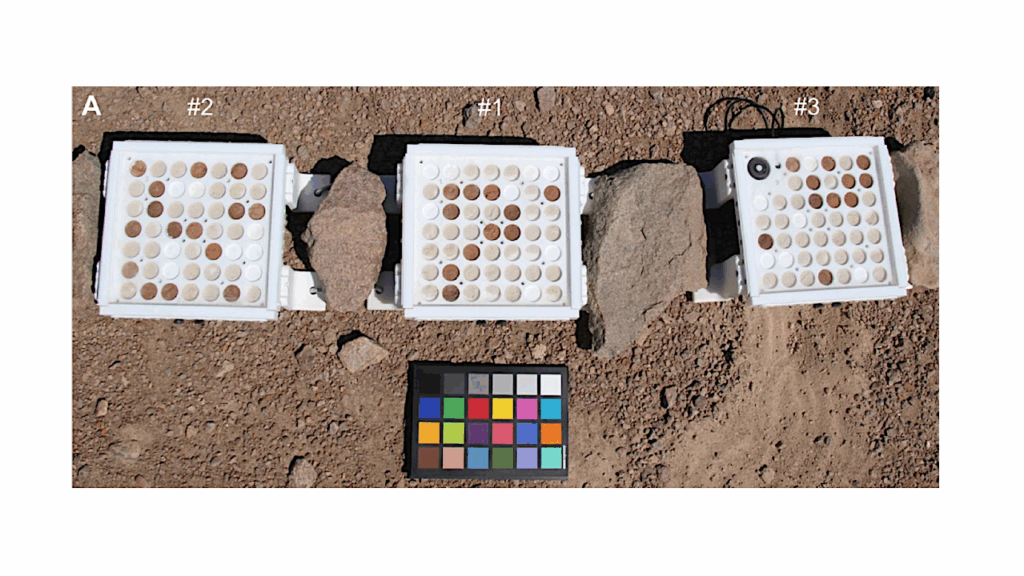Film Review: “The Martian”

The Martian is a really good movie. It would be a good movie even if it was not set in outer space. But it does happen in space and does so in superbly flawless fashion. The movie is fast-paced and really doesn’t miss a beat. Little time is wasted on things that do not support the story. You are on Mars with Mark Watney and you really want to see him get home. Minor spoilers below:
Having read Andy Weir’s entertaining book I had a basic idea of what would happen. The book often reads more like a lab manual of nightmare experiments (many of which are personally familiar) where you wish you paid more attention in class that are filled with somewhat incessant (but understandable) profanity. The film is a lot more streamlined and really focuses on the book’s core tale and peoples the story with characters you could really relate to. Lets just say that the book and the movie are faithful to one another. The movie works just fine if you have not read the book and is still surprising if you have read the book.

Every single frame in this film is gorgeous and stunning. I could not tell what surface visuals were shot on location on Earth and which ones were computer generated and I simply did not even stop to bother to think about that. That is quite an accomplishment in and of itself for a SciFi movie. Ridley Scott is renowned for his sweeping vistas and he certainly does not disappoint in this film. Indeed, the scenery (some of which was shot in Jordan) is on a par with what David Lean showed audiences in “Lawrence of Arabia” – but with highly accurate Martian phenomena included. It is that good.
As for how NASA is depicted – it is realistic. Snide cynicism and self-serving biases by a few upper management types (and one particularly snarky public affairs officer) are more than balanced by the sheer ingenuity and creativity of NASA’s rank and file. In the case of the crew, the aw-shucks jokery is intermeshed with unabashed bravery and out-of-the-box thinking. Of course there are the people in the film who break the rules – for the right reasons – my favorite type of NASA employee. In the balance: the way NASA is shown working (sometime against itself) is quite accurate. Alas, as is the case today, its almost as if one person at NASA can’t excel at something without having someone down the hall doing something stupid or selfish. But in the end the good guys prevail – since it is success that motivates NASA – even if they stumble a bit on the way.

If you are a space person then you only have two things to get your tech brain adjusted to – and it happens early on. To anyone watching movie trailers the premise is known that a sandstorm causes mayhem and destroys lots of stuff and one astronaut (botanist Mark Watney) is left for dead as the rest of the crew escapes. A hundred reviewers of the book and the movie have noted that Mars winds never get this intense. OK nerds, I get it. If you can get beyond that (maybe a large meteorite landed nearby or a volcano blew up) and just accept that something really bad and unexpected happened then the movie works. After all, things like this happen during expeditions to remote locations.
You also have to ponder why a human mission to Mars had a communications system back to Earth that was not fault tolerant with multiple back-ups. Lets assume that everything failed – for whatever reasons, since, things like that do happen in expeditions. And when multiple bad things happen in sequence you have a disaster and you eventually get documentaries about these disasters – just like “The Martian”. This is a movie – not a science class. The tech stuff is the backdrop against which someone desperately tries to get home – against all odds.

These nerd nits aside, I have to say that the look and feel of the movie – especially surface operations is spot on. Amazingly so. NASA’s copious input is blatantly obvious. Having spent three stints with space scientists on Devon Island aka “Mars on Earth” (building a “Mars Greenhouse” and playing Mark Watney myself), weeks at NASA Desert RATS in Arizona (where astronauts practice in their rovers), and a month living at nearly 18,000 feet at Everest Base Camp (with astronaut Scott Parazynski who is Mark Watney in real life – even if he doesn’t know it) I really felt like this movie depicted what a NASA Mars base would look like.
As for all of the hacking – the more the better. It is especially doable if you have a propensity for fixing stuff (like Mark Watney). Modern day NASA examples of orbital hackers include space station astronaut-tinkerer Don Pettit and solar array surgeons Scott Parazynski and Doug Wheelock. Anyone who has gone on an expedition with lots of gear will attest to the benefit of having the innate ability to fix things – and to do so in places where you never expected to fix these things. And when all the training leaves you drawing a blank, you need to create tools and procedures from experience to get you home.
As for hacking the old stuff: that old stuff used to work and, under the right conditions, it still can. Other than a few blinking lights on Pathfinder, everything that is depicted in the film is logical, feasible, and eminently doable. Of course, it helps if the folks back home can do some dumpster diving and find the original instruction manuals – and if the retired NASA folks who originally built the hardware return your call. Having been co-lead on the Lunar Orbiter Image Recovery Project and the ISEE-3 Reboot Project I can tell you that absolutely nothing beats the productivity and sheer can-do attitude of a retired NASA employee who is offered a chance to play with their old forgotten hardware one more time.
I have to assume that by the time this imaginary third human mission landed on Mars that all of the space agencies on Earth decided that there was no indigenous life on Mars. I say this since there is no evidence in this film of any concern for preventing cross-contamination whatsoever. A lot of this has to do with the sheer expediency that goes with being in survival mode. But the regular operations of this mission (as depicted) seem to have no qualms about bringing Martian regolith inside the base or allowing un-decontaminated space suits worn inside the base out on the Martian surface.

This issue of “planetary protection” is a contentious issue among scientists. Do we want to go to Mars to look for life only to be confused when we find life that we may have brought there? That said, this is a story about a human mission to Mars – one of a series of missions. It sort of goes without saying that if we are going to send humans to another planet that we have already made a decision albeit one that can be controlled – to risk contamination of that planet with life from Earth.
In the case of Mark Watney he had a “prime directive” sort of decision to make when it came to using the resources at hand on Mars even if he left a big mess behind. He chose to live. I certainly can’t say that I fault him for that. I’d like to think that I’d do the same thing.
But I think I’d find the disco music a little less annoying.
Astrobiology








